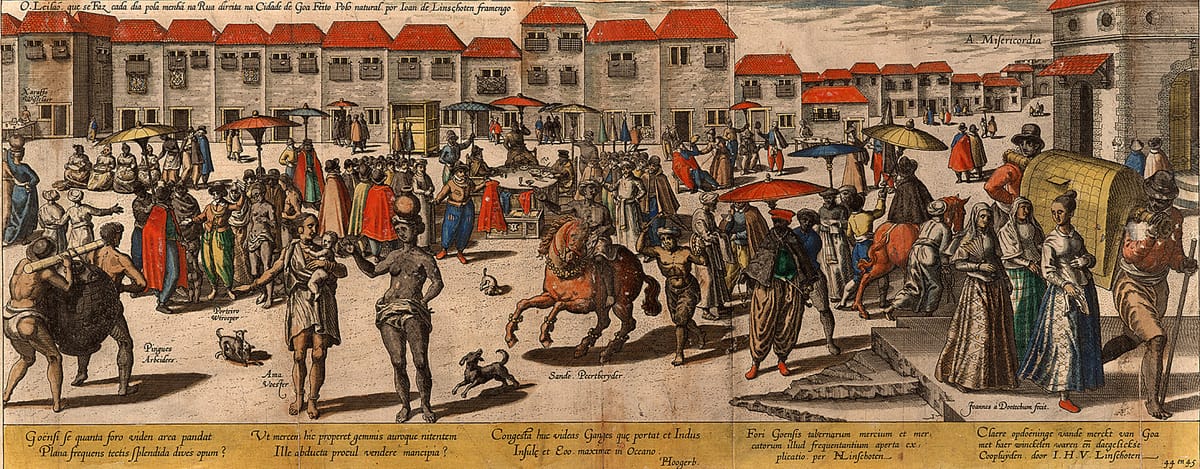Goa

Goa is located in the West coast of the Indian subcontinent, between Mumbai and Cochin.

It was occupied by the Portuguese in 1510 and in 1530 it became the capital of the Portuguese Estado da Índia.

Soon after occupying Goa in May 1510, the Portuguese were driven away from the city. They entered once again into the city in November 1510, and were besieged by Bijapur forces in the following year. The Portuguese settlement was ensured only in 1512.
The image shows Afonso de Albuquerque holding some fatally wounded soldiers after the Portuguese took the city for the second time.

After the occupation wars, the Portuguese had to rebuild Goa completely. The island was two leagues long and one wide. The Florentine explorer Andrea Corsali described the city less than one decade after its conquest as “one of the best things the Portuguese have in India”. It had strong defensive walls, a moat, a fortress connecting the city wall to the sea, and many houses “ordered in our way”.

As Goa became the capital of the Estado da Índia, its maritime trade rose steeply. Since the carreira da Índia ships were generally loaded at Goa, the city came into direct contact with the main trade centres in the Indian Ocean. It was also a hub for intra-Asian trade, as many inter-port voyages (regular trade voyages between different Indian Ocean centres) converged there.
Attracted by the low prices caused by the abundance of goods in the city, merchants flocked to Goa. In the sixteenth century, Goa became a cosmopolitan metropolis where people from all over Asia and Eastern Africa met.

Goa was also known by the Portuguese as “The Rome of the East”. In 1557, Goa became a Roman Catholic archdiocese, to which all the dioceses from Mozambique to Funai came to be subordinated. At the time of the Portuguese conquest, Goa was a Muslim-ruled city of mainly Hindu dwellers.
An initial tolerance toward the Hindu majority came to an end in the mid-sixteenth century as increasing numbers of Catholic missionaries established themselves in Goa. In 1560, the Holly Office commenced its operations in the city, and a grand palace was built for the Inquisition tribunal.

As the capital of the Estado da Índia, much merchandise flowed in and out of Goa. Persian and Arabian horses coming mainly from Hormuz were one of the principal goods traded in Goa. At a time when cavalry was the backbone of a state’s strength, such a commodity was vital. Muslim armies – influenced by Persian, Turkish and Mongol military traditions – also used elephants. They were also traded by the Portuguese factor in Goa for the king’s account. In addition to their military role, the elephants were an important symbol of power and status for Indian polities.
References:
Fernandes, Agnelo P. ‘Goa’s Role in the International Trade in 16th and 17th Centuries’. Proceedings of the Indian History Congress 48 (1987): 284–93.
Hespanha, António Manuel. Filhos Da Terra: Identidades Mestiças nos Confins da Expansão Portuguesa. Lisbon: Tinta da China, 2019.
Paiva, José Pedro. ‘The Inquisition Tribunal in Goa: Why and for What Purpose?’ Journal of Early Modern History 21, no. 6 (7 December 2017): 565–93.
Xavier, Ângela Barreto. ‘Village Normativities and the Portuguese Imperial Order: The Case of Early Modern Goa’. In Norms beyond Empire: Law-Making and Local Normativities in Iberian Asia, 1500-1800, edited by Manuel Bastias Saavedra, 32–71. Leiden, The Netherlands: Brill | Nijhoff, 2021.
Walker, Timothy D. ‘Contesting Sacred Space in the Estado da India: Asserting Cultural Dominance over Religious Sites in Goa’. Ler História, no. 78 (22 June 2021): 111–34.
Credit for featured image: https://commons.wikimedia.org/wiki/File:Rua_Direita_na_Cidade_de_Goa.jpg
